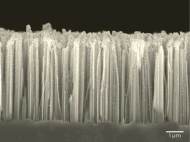More efficient hybrid nanowire–nanoparticle palladium catalyst
 Development of highly active and reusable solid catalysts based on precious metals, such as palladium (Pd), is crucial not only for organic syntheses but also for chemical and pharmaceutical processes. These rare and expensive catalytic materials are widely used in industry, so it is of great importance to find ways to minimize their consumption. Researchers at the RIKEN Institute have developed a nanostructured catalyst that makes extremely efficient use of trace amounts of catalytic palladium.
Development of highly active and reusable solid catalysts based on precious metals, such as palladium (Pd), is crucial not only for organic syntheses but also for chemical and pharmaceutical processes. These rare and expensive catalytic materials are widely used in industry, so it is of great importance to find ways to minimize their consumption. Researchers at the RIKEN Institute have developed a nanostructured catalyst that makes extremely efficient use of trace amounts of catalytic palladium.
There are many ways to utilize more efficient catalytic transformations. One approach is to reduce the volume of the reaction from macroscopic to microscopic scale by using microscale reactors. In that way, reagents are better directed to the catalyst’s active sites and increase efficiency of the reaction. Another approach involves attaching heterogeneous catalysts to materials that contain numerous tiny pores, such as mesoporous silica.
Although the catalysts exhibit such ‘nanospace’ reaction zones, the research team at the RIKEN Center for Sustainable Resource Science, led by Yoichi Yamada, has realized that existing designs are not suitable for passing large volumes of reagents. Researchers then turned to silicon nanowire arrays that are commonly used in optoelectronics, fuel cells and solar cells.
They developed the silicon nanowire array-stabilized palladium nanoparticle catalyst (SiNA-Pd). Firstly, they constructed a dense forest of nanowires projecting upward from a silicon wafer and then immobilized catalytic palladium nanoparticles on the upper part of the array. The hybrid catalysts are equipped with confined nano-size reaction fields surrounded by a lot of Pd nanoparticles on the square centimeter sized silicon wafer which should provide plenty of reaction capacity.
The research team has found that SiNA-Pd have high activity in Mizoroki-Heck coupling – a palladium-catalyzed carbon-carbon bond forming process which is widely used in the synthesis of pharmaceuticals and agricultural chemicals. Many coupling reactions preceded with perfect efficiency, even at small concentrations of Pd. Researchers have found that SiNA-Pd efficiently promoted other Pd-catalyzed reactions, such as carbon-hydrogen bond modifications.
Furthermore, SiNa-Pd has displayed flexibility on various scales. Larger-scale Mizoroki-Heck reaction experiments revealed that SiNa-Pd catalyzed over two million coupling reactions, at a rate of 40,000 per hour, without losing catalytic activity. That is the highest turnover ever recorded for this reaction with immobilized catalysts.
Yamada notes that this reusability may stem from two synergistic factors: nanospaces on the silicon array that efficiently trap palladium nanoparticles and favorable chemical interactions between silicon and palladium that stabilize nanoparticle immobilization.
RIKEN research team plans to examine industrial applications of this highly active and reusable novel catalytic platform, as well as light-medited chemical transformations that take advantage of the silicon nanowire’s optical activity.
For more information, you can read the article published in the Angewandte Chemie International Edition: “A Palladium-Nanoparticle and Silicon-Nanowire-Array Hybrid: A Platform for Catalytic Heterogeneous Reactions” [935KB PDF].









Leave your response!